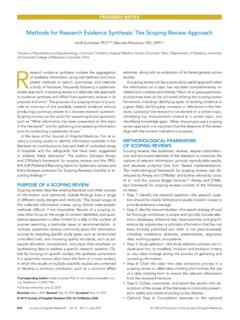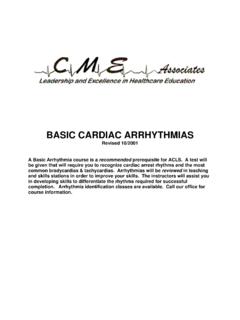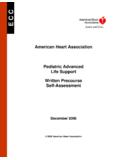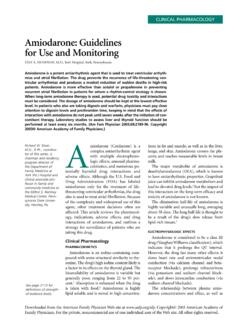Transcription of Which psychotropics carry the greatest risk of QTc ...
1 36 Current PsychiatryOctober 2012 Vicki L. Ellingrod, PharmD, BCPP, FCCP Series EditorSavvy PsychopharmacologyMrs. A, age 68, has a 40-year history of schizoaffective disorder with comorbid anxiety disorder not otherwise speci-fied, type 2 diabetes mellitus, and hypertension. She takes furosemide, 40 mg/d, lisinopril, 20 mg/d, and metformin, 2,000 mg/d, for hyperten-sion and diabetes; lorazepam, mg/d, and par-oxetine, 40 mg/d, for anxiety; and quetiapine ex-tended release, 800 mg/d, for psychotic features and mood dysregulation with schizoaffective dis-order. Mrs. A s husband died 5 years ago and she lives alone in a senior care facility.
2 Mrs. A uses a weekly pill reminder box because her residential facility does not monitor medication adherence. She sees her psychiatrist once a month and her primary care provider every 3 months. She has no history of illicit drug, alcohol, or tobacco use. Two weeks ago, Mrs. A was found leaning against the wall in a hallway, complaining of dizziness and disorientation, and unable to find her way back to her apartment. In the emer-gency department, her serum potassium is low ( mEq/L; normal range: to ), fasting glucose is elevated (110 mg/dL; range: 65 to 99), and ECG reveals a prolonged QTc interval of 530 milliseconds.
3 Before this episode, Mrs. A had been medically stable without mood or psychotic symptoms, although her daughter reported medication self-administration was becoming difficult. Exposure to psychotropics carries a risk of QTc prolongation. The QT interval is an ECG measure of ventricular depolar-ization and repolarization. The QTc des-ignation indicates a correction for heart rate with increasing heart rate correlating with a shorter QT interval. Readings of 440 milliseconds are considered QTc prolongation is defined as >450 millisec-onds for men and >470 milliseconds for An increase in the QT interval is a predictor of serious cardiac Antidepressants and antipsychotics have been associated with QTc prolonga-tion.
4 When identifying agents that could disrupt cardiac conduction, clinicians need to consider whether the drug s molecular structure, receptor affinity, or pharmaco-logic effects are most Although these may be important, patient-specific variables that increase the risk of QTc pro-longation may have greater impact. These include: age >65 female sexWhich psychotropics carry the greatest risk of QTc prolongation?Nicole B. Washington, DO, Nancy C. Brahm, PharmD, MS, BCPP, CGP, and Julie Kissack, PharmD, BCPPDr. Washington is Assistant Professor, Department of Psychiatry, School of Community Medicine and Dr.
5 Brahm is Clinical Professor, College of Pharmacy, University of Oklahoma, Tulsa, OK. Dr. Kissack is Professor and Chair, Department of Pharmacy Practice, Harding University College of Pharmacy, Searcy, Points Screen patients for risk factors for prolonged QTc interval, such as congenital long QT syndrome, family history of cardiac conduction abnormalities, and previous occurrences of medication-mediated QTc prolongation. Obtain baseline and steady state ECG when initiating high-risk agents, particularly when administering combination therapy. Use the lowest effective dose of antidepressants and antipsychotics and monitor symptoms closely.
6 37 Current PsychiatryVol. 11, No. 10 Savvy Psychopharmacology electrolyte imbalances (specifically low serum potassium and magnesium levels) high or toxic serum levels of the sus-pected drug preexisting cardiovascular impair-ment, such as ,5 Other risk factors include concurrent use of an agent with similar cardiovascular effects or one that competes for metabolism (either enzymatic or at the binding site), physiologic limitations such as renal insuf-ficiency, and medication changes that may increase or decrease psychotropic ,6 Geriatric patients with dementia have an increased risk for cardiovascular- related ,8 AntidepressantsAmong tricyclic antidepressants, most reports of QTc prolongation involve ami-triptyline and Risk factors include demographics (eg, female sex, age), personal or family history (congeni-tal long QT syndrome, cardiovascular dis-ease)
7 , and concurrent conditions or drug use, particularly those associated with QTc Desipramine and nortripty-line also have been identified as high-risk QTc prolongation has been reported with all selective serotonin reuptake inhib-itors at plasma concentrations above the therapeutic Fluoxetine-associated QTc prolongation was limited to cases of overdose or when additional risk factors were QTc prolongation from psychotropics could increase the risk of torsades de pointes , according to an analy-sis of the FDA Adverse Event Reporting In 2011, the FDA reported an in-creased risk of abnormal heart rhythms including QTc prolongation with citalo-pram doses >40 Although cases of QTc prolongation with paroxetine have not been reported,11 the Arizona Center for Education and Research on Therapeutics lists paroxetine with other agents that may increase the risk for QTc prolongation with concurrent use of medications that may prolong QTc Venlafaxine doses >300 mg/d may require additional cardiac.
8 12 Data from venlafaxine poi-soning case reports found a positive cor-relation between dose and QTc In a review of toxicology database information, Wenzel-Seifert et al4 found extended QT interval with citalopram, fluoxetine, and venlafaxine at toxic doses or in the presence of additional risk factors such as sex, older age, or personal or fam-ily history of congenital long QT syndrome or cardiovascular reports, case series, and research tri-als have evaluated the risk of QTc prolon-gation with antipsychotics (Table).1,2,4,16,17 The first-generation antipsychotics thio-ridazine,4,16,18 mesoridazine,16,18 chlorprom-azine,19 and haloperidol3 warrant cardiac monitoring.
9 The QTc prolongation effects of thioridazine and its active metabolite AntipsychoticApproximate QTc interval prolongation in millisecondsbAripiprazole4,17-1 to -4 Clozapine410 Haloperidol1,27 to 15 Mesoridazine1639 to 53 Olanzapine12 to to 4 Pimozide219 Quetiapine1,26 to 15 Risperidone1, to 10 Sertindole130 Thioridazine2,1633 to 41 Ziprasidone1,216 to 21a List is not comprehensive. Other antipsychotics may be associated with QTc prolongationb QTc prolongation interval may depend on the route of administrationExamples of QTc prolongation associated with select antipsychoticsaTableClinical PointQTc prolongation has been reported with all SSRIs at plasma concentrations above the therapeutic levelDiscuss this article at CurrentPsychiatry38 Current PsychiatryOctober 2012 Savvy Psychopharmacologymesoridazine are well-documented and thioridazine-mediated QTc prolongation increases are ,18 ECG monitoring is recommended with IV hal-operidol.
10 Which is used for delirium in QTc prolongation has been associ-ated with long-term ziprasidone use more often than with risperidone, olanzapine, or Ziprasidone prolongs the QTc interval an average of 20 millisec-onds,21 Which could represent a clinically significant change. QTc prolongation for iloperidone is comparable to ziprasidone and There is some evidence that aripiprazole may shorten, rather than prolong, the QTc ,17 Cardiovascular adverse effects associat-ed with clozapine including QTc prolon-gation are Olanzapine prolongs QTc interval, although the mean change is less than with other agents un-less other variables were present, such as: concomitant use of medications that may prolong QTc interval (ie, amanta-dine, hydroxyzine, or tamoxifen2) preexisting cardiovascular conduction disorders higher doses (>40 mg/d).











